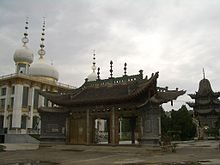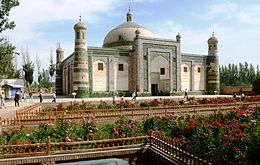Afaq Khoja
Afaq Khoja | |
|---|---|
 The tomb of Afaq Khoja near Kashgar | |
| Born | Hidayat Allah 1626 |
| Died | 1694 |
| Resting place | Ayziret, Xinjiang, China |
| Part of a series on Islam in China |
|---|
 |
|
|
Afaq Khoja (Uyghur: ئاپاق خوجا), born Hidayat Allah (Uyghur: هدایتالله; Chinese: 伊達雅圖勒拉), also known as Apaq Xoja or more properly[note 1] Āfāq Khwāja (Persian: آفاق خواجه), was a Naqshbandi īshān[1] and political leader with the title of Khwaja in Kashgaria (in present-day Southern Xinjiang, China). He was also known as Khwāja Hidāyat Allāh (خواجه هدایتالله).
Spelling variants
In Chinese, Afaq Khoja is known as 伊達雅圖勒拉; Yīdáyǎ Túlēilā. His name is also written as 阿帕克霍加 (Āpàkè Huòjiā) or 阿帕克和卓 (Āpàkè Hézhuō) and occasionally just 阿帕霍加 (Āpà Huòjiā); Khoja may also appear as 和卓 (Hézhuō). In the Uyghur Latin alphabet, it is written as Apaq Xoja and in Modern Uyghur script as ئاپاق خوجا.
Biography

Under the later Chagatai Khans, Islam recovered from the set-back it had received from the invasions of Chengiz Khan and his immediate successors, thanks mainly to the influence of Bokhara and Samarcand, which had become important centres of Moslem learning. During the reign of Rashid Khan, the celebrated saint Sayyid Khoja Hasan, more generally known as Makhdum-i-Azam (مخدومِ اعظم) or "The Great Master", visited Kashgar from Samarkand and was received with extraordinary honours. The saint's sons settled at Kashgar, where their father had married a wife and had received rich estates, and gradually established a theocracy, laying upon the necks of the submissive, apathetic people a heavy yoke which they still bear. In course of time two parties were formed whose influence on the subsequent history of the country has been profound. The supporters of the elder son were termed Ak Taulin or "White Mountaineers", from the name of the range behind Artush, their headquarters, whereas the supporters of the younger were known as Kara Taulin or "Black Mountaineers", from the hills near Khan Arik. Both parties of Khojas. as they were termed, aimed at political supremacy and intrigued with any external power that appeared likely to favour their ambitions.
— Sir Percy Sykes and Ella Sykes.[2]
Afaq Khoja was a great-grandson of the noted
Among some Uyghur Muslims, Khoja Appak was considered a sayyid or descendant of Muhammad. As a highly respected religious figure, he was in a clash with ruling elite of the Chagatai (Moghul) dynasty and this conflict had both a religious and secular nature. For the religious part he was an advocator of implementing Islamic Sharia law against Mongol Yassa law which was in force at that time while for the secular part he heavily criticized the luxurious lifestyle which the ruling elites enjoyed. This clash proved serious due to the fact that Chagatai Khan (c. 1185–1241 or 1242) had been appointed by Genghis Khan to see if the Yassa was observed[3] so it eventually resulted in expelling of Afaq Khoja by Ismail Khan (1669, 1670–1678), the later ruler of the Yarkent Khanate. Since the Ishaki Khojas were another offshoot of the Naqshbandi Sufis, Ismail Khan purposefully approached the Ishaki khojas (also known as the Kara Taghliks, i.e. Black Mountain Khojas) to balance Afaq Khoja influences and prevent dangerous propaganda against him by followers of Afaq Khoja. This clash between religious sects worked to Ismail Khan's advantage. However, the exiled Afaq Khoja had accomplished a diplomatic mission that had led to the collapse of Chagatai (Moghul) dynasty in 1678. In this diplomatic mission Tibet Muslims played a crucial role by convincing the 5th Dalai Lama to write a letter of introduction to the Dzungar Khanate.[4] Using this recommendation letter Afaq Khoja allied with the Dzungars and formed a strong coalition force which included some Chagatai (Moghul) royal family members such as Abdirishit Khan II, Muhammad Imin Khan and Muhammad Momin Akbash, who were against Ismail Khan. Moreover, there were a significant numbers of followers of Afaq Khoja inside the Khanate so that the profile of the Afaq Khoja increased considerably. The Dzungar leader Galdan Boshugtu Khan then launched the Dzungar conquest of Altishahr, conquered the Yarkent Khanate and then installed Afaqi Khoja as one of their puppet rulers.

In 1691 a temporary alliance between Muhammad Imin Khan, son of Sultan Said Baba Khan, who was previously recalled from

After this victory Afak Khoja declared his son Yahiya Khoja a Khan with the title Khan Khoja and made himself a powerful ruler controlling several cities around the
Afak Khoja died in 1694 and left his son Yahiya Khoja as actual ruler of the Yarkand Khanate (r. 1694–1695). After Yahiya Khoja's death (he was killed by Apak Khoja's wife Khanam Padshah, who was a daughter of Sultan Said Baba Khan, ruler of Turpan and Chalish), Muhammad Mumin Sultan (Akbash Khan, r. 1695–1706) restored the Chagatay (Moghul) dynasty of Yarkand, attempting to get rid of the Dzungar mandate, but finally he fled to India. Kashgaria was soon reconquered by Dzungar Khan Tsewang Rabtan in 1713.
Influence on Islam in China

Afaq Khoja's influence spread far outside of Xinjiang. From 1671-72, he was preaching in
there to Naqshbandi Sufism.According to the Chinese (Hui) followers of the Qadiriyya Sufi school, when Afāq Khoja was in Xining in 1672, he gave his blessing to 16-year-old Qi Jingyi (later also known as Hilal al-Din, or Qi Daozu (1656–1719)), who was then to introduce Qadiriyya into China proper. His two other spiritual descendants, Ma Laichi and Ma Mingxin, went to study in Central Asia and Arabia, and upon return to China founded two other Naqshbandi menhuans (brotherhoods) there: the Khufiyya and the Jahriyya, respectively.[5]
The Afaqis
Khoja Afaq's descendants, known as the Āfāqi
The next strong Dzungar ruler,
In the 1750s, two Afaqi Khoja descendants, the brothers
According to a legend, Iparhan, granddaughter of Apak Khoja was given to the Qianlong Emperor as a concubine. Under Qing auspice, Khojijan rulers of city states often fell out of favor of the hegemonic power and had to flee to Uzbek protection in the Khanate of Kokand.
By the 19th century, prominent Afaqi Khojas (Khojijans) in exile in Kokand sought to influence their former domains through preaching or allying with new imperialist powers of
suzerainty.Well into 20th century, there were still local princely families of
The Qarataghliks (Black Mountaineers) propagated anti-Afaq Khoja literature. For his action of inviting Dzungar invasion and rule, Afaq Khoja is viewed as a perfidious betrayer collaborator by some Uyghur nationalists while he and his grave was still honored and revered as a saint by other Uyghurs.[6] The power of miracles and the equivalent status of Jesus (Isa) in Islam have been attributed, according by some Uyghurs, to Appak Khoja.[7]
Afāq Khoja Mausoleum
"This was the famous shrine, and we were invited to step inside, where we saw a crowded mass of bluetiled tombs, that of the Saint-King being draped with red and white cloths. There were numbers of flags and banners before the tombs, and on one side was a palanquin in which a great-grandson of Apak had travelled to and from Peking. While there he had married his daughter to a Chinaman, and at the date of our visit a Celestial had arrived in Kashgar accompanied by a band of relatives, to demand his share of the great wealth of the shrine. His credentials were unexceptionable, and during a century and a half his ancestors had been given pensions by the Chinese Government; but owing to the revolution these subsidies had been stopped. Hence his appearance, which was causing much perturbation among the managers of the shrine funds." - Sir Percy Sykes and Ella Sykes. Sykes, Ella and Percy Sykes. pages 69-70 Through deserts and oases of Central Asia. London. Macmillan and Co. Limited, 1920.

Afāq Khoja's mausoleum is considered the holiest
Notes
- ^ Khwāja Āfāq or Khoja Afaq, are spellings preferred by modern scholars, e.g. Kim (2004) or Gladney (1999).
References
- ^ Aliya de Tiesenhausen (2022). The Social Role of Art and Culture in Central Asia.
- ^ Sykes, Ella and Sykes, Percy. page 269 Through deserts and oases of Central Asia. London. Macmillan and Co. Limited, 1920.
- ^ "Mongol Laws: the Yassa". Elibrary.sd71.bc.ca. Retrieved 2013-06-02.
- ^ 安瓦尔, 巴依图尔. 略论阿帕克和卓 (PDF). China Academic Journal Electronic Publishing House. Archived from the original (PDF) on 2012-03-23. Retrieved 2011-05-05.
- ^ Gladney (1999)
- ISBN 978-0-674-96702-1.
- ISBN 978-1-317-64721-8.
Literature
- Kim Hodong, "Holy War in China: The Muslim Rebellion and State in Chinese Central Asia, 1864-1877". Stanford University Press (March 2004). ISBN 0-8047-4884-5. (Searchable text available on Amazon.com)
- Originally published in "Muslim Diversity: Local Islam in Global Contexts". Leif Manger, Ed. Surrey: Curzon Press. Nordic Institute of Asian Studies, No 26. Pp. 102–149
- Rian Thum, "Beyond resistance and nationalism: local history and the case of Afaq Khoja". Central Asian Survey, 31:3, 293-310 (October 2012).
